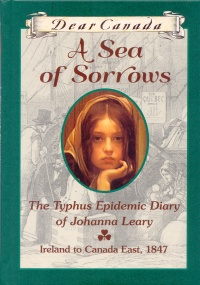| ________________
CM . . .
. Volume XIX Number 6 . . . . October 12, 2012
excerpt:
A prize-winning author of teen mysteries, Norah McClintock has turned her talents to historical fiction with the story of 13-year-old Johanna Leary who flees the 1847 Irish famine, along with her 14-year-old brother, Michael, her baby brother Patrick, and their parents. McClintock works essential background information about the "great hunger" into the story, avoiding the danger of turning her story into a history lecture. Like the other novels in the “Dear Canada” series, Sea of Sorrows has an historical note, a map, in this case of Eastern Canada (where many of the Irish immigrants settled), and illustrations, specifically six 19th century illustrations of the famine and the exodus from Ireland. Aboard ship, Johanna and her brother meet a rough girl and learn eventually that "she" is a boy. Connor is in disguise because he is wanted by the authorities for threatening and robbing some landlords. Connor survives the voyage and plays a role in bringing about the eventual satisfactory outcome, but he and Johanna do not end up together, as is usual when boy and girl meet in this sort of journey novel. Death was no stranger to Irish immigrants in the 1840s, a fact that McClintock shows without being too graphic. Johanna's mother and younger brother die on the voyage, and, on arriving, Johanna's father is sick and is taken to a hospital. Johanna is also separated from her elder brother when she is given food clothing and shelter by nuns and he gets a job. A troubling scene shows the separation of two brothers who are already overwhelmed by the loss of the rest of their family. Working in a convent, Johanna declines the offer of a home with a French Canadian family as she is convinced that her father and brother Michael are still alive and that Uncle Liam awaits news of them. Eventually, after learning of her father's death and Michael's disappearance, Johanna accepts a placement with a family. Although most Irish children were placed by the Roman Catholic Church in Quebeçois homes, Johanna is the exception to the rule; she is sent first to one Anglophone family, then to another. Perhaps McClintock made this narrative decision because she wanted to show child exploitation while avoiding negative portrayals of French Canadians. McClintock effectively presents the anti Irish bigotry of the day. Canadian children of today who read this novel may well have friends and classmates from many different ethnic backgrounds. In sympathizing and identifying with Johanna, they will see the unfairness of generalizing about people from other cultures. How did Johanna happen to be literate enough to keep a diary? During the 18th century, when Catholics were prohibited by the penal laws from getting an education, a clandestine system of "hedge schools" grew up in which priests taught the "three Rs", including English and Irish grammar. In the 1830s, a national school system was established, but, given the widespread rural poverty which became catastrophic in the 1840s, it is hard to imagine that Johanna got much formal book learning. McClintock cleverly finds an explanation that avoids the history of Irish education: Johanna's maternal grandfather, a school teacher in England, taught his daughter who, in turn, taught her own children, including Johanna. Since the diary form encourages reportage rather than dramatization, and is, by definition, episodic, it takes a capable author to create vivid scenes and build tension. McClintock has an eye for key detail to bring scenes to life. In one diary entry, she blends a description of brilliant autumn foliage with Johanna's rug braiding. The reader sees Canadian autumn glories through a newcomer's eyes while learning about one aspect of pioneer women's work. At the outset, there is an implied promise to the reader that, in the end, Johanna will either reach a safe haven with Uncle Liam or find an adequate life elsewhere. The novel ends when Johanna learns that her brother Michael is living with Uncle Liam near Peterborough, Canada West, but that she will have to wait till spring, when the St. Lawrence River is passable again, to be reunited with them. The reader, hoping for a big reunion scene, feels cheated. Then comes a six page epilogue summarizing the rest of Johanna's life, from mid teens to old age. All “Dear Canada” novels have epilogues for readers who "must know what happened next", and McClintock has ably fulfilled that requirement with a realistic account of the rest of Johanna's adult life. Yet, if McClintock had been allowed to present the epilogue in diary form, say, as Johanna's reflections after rereading her teenage diary, the novel would have ended on a more conversational, vivid note. Norah McClintock has effectively applied her writing experience to this novel, but her talent is best displayed in her other books in which she was not constrained by the special requirements of a series. Recommended. Ruth Latta's latest novel, The Old Love and the New Love, (Ottawa, Baico, 2012, baico@bellnet.ca) required research into Irish history.
To comment on this
title or this review, send mail to cm@umanitoba.ca.
Copyright © the Manitoba Library Association. Reproduction for personal
use is permitted only if this copyright notice is maintained. Any
other reproduction is prohibited without permission.
NEXT REVIEW |
TABLE OF CONTENTS FOR THIS ISSUE
- October 12, 2012.
AUTHORS
| TITLES | MEDIA REVIEWS
| PROFILES
| BACK ISSUES
| SEARCH | CMARCHIVE
| HOME |
